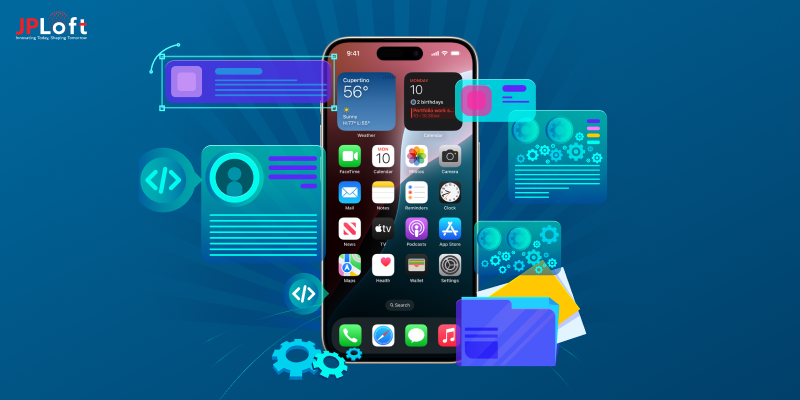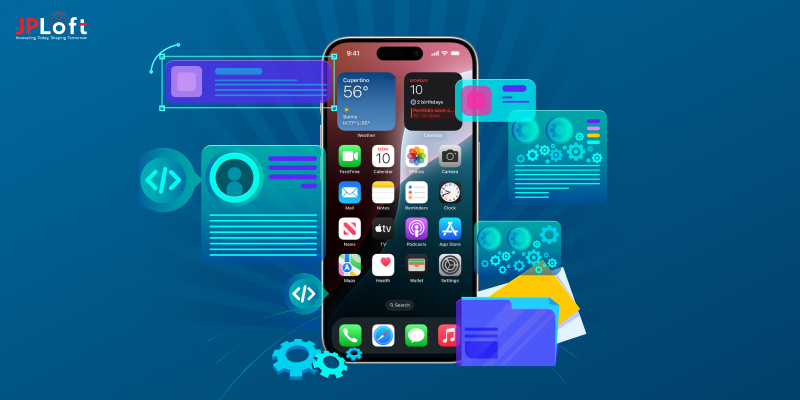With more than 21.6 million smartphone users across Australia, smartphones are integral to daily life. Companies are joining the wave and creating their applications.
There are around 2.2 million apps in the Apple App Store and 3.3 million apps on the Google Play Store, mobile application development is an important element for firms who want to boost their web presence and interact with customers in innovative methods. With this huge number, about 58% of applications are developed by Australian developers.
Are you seeking to improve your business's presence within Australia? Do you want to build a mobile app that could help increase your customers? Australia has an app market whose revenues have been growing by $1 billion in the past couple of years. Exploring tech startup ideas could be a strategic way to capitalize on this growth.
A study has revealed that nearly four-fifths (or more) of Australian people use smartphones regularly. Thus, developing mobile applications is crucial to every business in the modern world. However, developing mobile apps for businesses can be a challenge. Companies' main question is, "How much does it cost to develop a mobile app for the business?"
In this blog, we'll examine the cost of development and focus on factors that affect the costs of mobile apps available in the marketplace. Follow the blog for more information on the costs of mobile app development within the Australian market.
Understanding Mobile App Development Cost
There must be a universally applicable solution to the costs of mobile app development in Australia. Costs vary widely depending on the developer you're willing to work with and your application's complexity level. The typical range of expenses for creating a mobile app in Australia is between $10,000 and $100,000. The price will vary based on different aspects of the application.
Factors Affecting Mobile App Development Costs in Australia
The mobile app market has never been this vast, as a large variety of businesses use apps on mobiles and web-based apps to connect with their target audience. From mobile and eCommerce games to social networks, food delivery, and even educational tools, there's an app that can meet nearly any need.
However, the price of making these apps is determined by various crucial factors. Here are some of the key factors that affect the cost of mobile app development Australia.
App Complexity & Features
The functionalities and features of apps are essential in calculating the cost of developing a mobile application in Australia. Its features include an AI-powered chatbot, protection safeguards (data encryption, authentication of users), push notifications search and filtering virtual test-ons, third-party integration, and more. These all play a role in the success of an app and its cost for development. The more sophisticated and rich in-app features, the greater the development costs.
Below is a short chart outlining the mobile application's development costs in Australia and its quality and complexity.
-
Simple App with Basic Features: $30,000-$80,000 (AUD45,000-AUD120,000)
-
Medium Complex App with Moderate Features: $80,000-$200,000 (AUD120,000-AUD300,000)
-
Highly Complex App with Advanced Features: $200,000-$300,000 (AUD300,000-AUD 450,000)
Platform Selection
Whether to develop an application for iOS, Android, or both is still up to you. Before you choose, bear in mind that the choice of a platform can affect the cost of making the app available in Australia. Developing a cross-platform app can be an affordable solution for companies that require a presence across both iOS and Android because it removes the need to separate development steps, saving time and effort.
UI/UX Design
The design of the UI and UX is a major factor in determining the cost of app development. Customized, high-quality designs that include stunning graphics, high-end animations, and user-friendly interfaces not only increase an app's appeal but also improve the development and design duration, which results in higher expenses.
Development Team Location
The primary costs for mobile app development are the location and experience of the development team. Employing app developers in Australia usually increases expenses due to the nation's lifestyle standard.
Development Team's Experience & Expertise
Experience and knowledge of the firm that creates applications can also impact the cost. An IT business that has won awards and experts in the field could have a higher price than a standard development business. However, the quality of the products far exceeds the initial development costs. Remember that selecting the correct app development company could significantly affect the development's timeframe, budget, and, of course, the quality of the application.
Tech Stack
The decision to pick the right technology stack (programming frameworks, languages, and applications) is a crucial element that can directly impact app development costs and the timeframe. As an example, using the most popular technology or frameworks, such as React Native or Flutter, can save money by allowing simultaneous development across different platforms as opposed to developing natively for every platform on its own.
Regulatory Compliance
Making sure that you are in compliance with regulations, such as HIPAA for healthcare, GDPR for data security, WCAG in accessibility standards, PCI-DSS for finance, etc., is among the crucial steps of app development. In Australia, Compliance with the Privacy Act 1988 is a must, particularly for applications that handle sensitive user data.
Compliance with legal and industry laws requires extra development efforts and takes longer, increasing the development cost. While adherence to regulations and compliance could increase the cost of developing mobile applications in Australia and elsewhere, it's essential to prioritize this element to ensure users' information security and avoid expensive complications in the future.
App Type
This kind of app will be one of the main factors that affect the development costs of mobile apps in Australia. Examples include healthcare apps such as Health-People, which must be integrated with medical databases and adhere to strict data privacy rules, increasing their cost and complexity.
App Maintenance Cost
The overall cost of developing an app for mobile devices in Australia includes after-launch maintenance and support costs that ensure long-term stability and continuous app performance. Therefore, regular maintenance for corrections to bugs, brand-new features, and regular updates must also be considered when assessing the budget allocated to develop an app. According to the industry norms, it is recommended that approximately 10 percent of the budget be set aside for maintenance expenses in Australia.
Strategies to Reduce Mobile App Development Costs in Australia
The development costs for the development of an app in Australia are significant. Fortunately, there are methods that you can use to help keep costs down. These are some of the many strategies and best techniques to lower the cost of developing mobile apps in Australia.
Define Clear Requirements Early On
Determining the app's specifications, features, and objectives prior to the start of the process can help prevent the scope from expanding and reduce unnecessary costs. If you plan ahead and define the goals, you will be able to build an effective app on time, even with a small budget!
Cross-Platform Development
Instead of creating distinct native applications for iOS and Android, it is possible to opt to develop cross-platform apps. This can dramatically cut costs, speed up the process, and save resources by allowing the creation of one app that functions smoothly across all platforms.
Minimum Viable Product (MVP)
Before investing in a complete and feature-rich app, you can concentrate on developing core functionality before introducing new features to future updates. This MVP method lets you begin the process sooner and then iterate the app based on user feedback, increasing funds and cutting development expenses.
Agile Development Practices
The adoption of agile development techniques, using their iterative and gradual approach, will help improve the efficiency of development. Continuous reviews, feedback loops, and flexible changes ensure that the project is on the right course and eliminate the necessity for expensive revisions.
Outsource App Development
Selecting the right development team to hire is crucial, as it can impact your product's budget, time frame, and quality. Instead of bringing on freelancers or hiring a temporary team in-house, it is possible to outsource the development of your own team, offering high-quality apps at a cost-effective price.
Steps for Mobile App Development in Australia
.webp)
It is essential to follow a step-by-step process of creating a mobile app easily and quickly. These are the steps you should follow when developing a mobile application:
Decide on the Mobile App Type
The initial step in developing mobile apps is choosing the type of app you wish to create. Mobile applications are divided into three categories: native applications, hybrid apps, and cross-platform apps.
-
Native applications: These are platform-specific applications. They're developed to run natively on a device's operating system, such as iOS or Android. Their speed, reliability, and ability to run offline make them appealing. They're designed using a programming language that is compatible with the device's operating system.
-
Hybrid mobile applications: Combine elements from native and web-based apps. They can run across multiple platforms using the same codebase, and they're easier to create and maintain. They're developed using web-based technologies like HTML5, CSS, and JavaScript.
-
Cross-platform mobile applications: These apps use the same codebase across multiple platforms, similar to hybrid applications. They are, however, developed using frameworks such as React Native, Flutter, and others rather than Web technologies to create hybrid mobile applications.
Research and Planning
If you've identified the type of app you wish to create for your company, research your app's target market and potential users. Be aware that your application performance depends on how comprehensive your study is. When conducting your research, be sure to get responses to queries such as
-
What are the chances that your app will get noticed by the public?
-
Who are your ideal customers?
-
How powerful are their rivals?
-
What is the weakness of your competition?
-
What are the features that audiences are looking for?
-
What is your most distinctive advantage?
-
How much money should you allot?
And so on.
Answering these questions can help you envision how you'll develop the application. Surveys can be conducted online or via paper-based surveys to gain insight into your audience's needs. When you conduct the survey, include questions about the application's capabilities, specifically what features users want to see within the application. This helps you figure out the distinctive selling points of the application.
Decide on the App's Features
Based on the survey and market research information, Choose what features you would like to incorporate into the mobile app. Choose three to five key aspects and then focus on the features you want to include.
The idea is that adding additional features makes your app more popular. However, the more features you have, the more likely you will struggle to create your app. This will affect your app's design, making it more difficult for users to navigate the app.
Instead of including ten or more features, you should only include those necessary for your target users since a typical user will likely use only three or five functions on an application.
If, for instance, your application is intended to achieve a specific purpose, think about making the app solely concentrated on one aspect. Do not add or consider other features as secondary to the principal element.
WireFraming and Prototyping
It is a crucial stage during the creation procedure. A wireframe is an initial sketch of the app's user interface. It shows how to navigate and includes images of the app's look and function.
Wireframing and prototyping help the developers and other team members understand how the app will perform and its core principles. Therefore, it is important to clearly define navigation elements, pages, elements on the page, object categories, areas for conversion, Call-to-Action buttons, etc.
There are various tools for creating wireframes, such as Balsamiq and Sketch. These programs allow you to create easy and clean wireframes. However, you may also draw wireframes on an unfinished piece of paper.
UI/UX design
You can proceed with the UI/UX design when the wireframes and prototypes have been created. The UI (User interface) and UX (User Experience) are the primary elements of designing mobile apps. UI is designing visually appealing elements for an app, such as icons, buttons, toggle screens, and so on. These components allow users to use the application. Additionally, UX refers to the entire experience you get from the app, which includes what you feel when using the app.
App Development Phase
The process of developing an app is an important step in the development of mobile applications. It is when you write code for an application for mobile devices using various technologies. Make sure you use mobile app development tools and technologies suited to the type of app you wish to create: top Flutter, Mendix, Xamarin, Ionic, and other tools for developing cross-platform apps.
To develop native mobile apps, you can use one of the following methods: Java, Python, Kotlin, Swift, Objective C, C++ or C++. For cross-platform mobile applications, pick one of these technologies: HTML, CSS, Objective C, Flutter, React Native, Xamarin, and many more.
Furthermore, three distinct areas need to be considered when developing mobile applications. These areas include the front end and the Application Programming Interface (API). The front end is the part that users can see and interact directly with. The backend is the behind-the-scenes part of the app that handles the data and processing. API helps facilitate data exchange between various software systems.
App Testing
When the development of an app is completed, the following phase is to verify the capabilities of the newly developed mobile application. Perform a range of tests such as tests for performance and test of compatibility, unit testing, usability tests, systems testing, acceptance tests, and beta testing, among others. Testing mobile apps helps to identify problems, verify that aspects function correctly, and confirm their efficiency and compatibility. If you find any issues, then fix it.
App Launch and Deployment
The last stage of the development of mobile applications is the launch of apps and their deployment. When you're satisfied with its overall function, this is the time to publish the mobile applications you have developed for the general public—the mobile applications for the Google Play Store or Apple App Store. However, before you submit a mobile app to the apps, you must follow the mobile app launch checklist. The checklist for launching mobile apps comprises guidelines and rules to be considered in the lead-up to, during, and following the release in the app's marketplace. Failure to follow a mobile app launch checklist may cause mobile applications to fail.
Maintenance of the App
Making a mobile app does not just require writing code and the launch of an app. The app also needs ongoing upkeep. This involves the introduction of updated versions of the application that improve security, as well as making changes to features and capabilities in response to user feedback and the market's reaction. If your app is not up to date with the demand of the market, it can result in a decrease in the engagement of users. Additionally, keeping your application current helps you remain ahead of the pack and outdo your competition.
Conclusion
Many aspects must be considered in determining the cost of creating an application for Australia in 2025, including the application's complexity, characteristics, design requirements, and developer experience. A primary application could cost between AUD 30 and AUD 70,000, and more advanced apps with sophisticated features can cost from AUD 100,000 up to 250,000 and even greater. Customizing integrations, customizations, and support after launch will affect the cost.
It's crucial to partner with a dependable Custom Software Development Company to ensure that your application is created with precision, speed, and high quality. Investing in a professional development service will not only help provide the highest-quality product but also keep in keeping with market requirements and customers' expectations within Australia.
Additionally, as the tech environment changes, participating in initiatives such as the Australian Technologies Competition will provide invaluable information, networking opportunities, and partnerships that could improve your app's success.
The expense of developing an app in Australia is contingent on various aspects; however, with proper planning, a careful choice of partners for development, and keeping up-to-date with market trends, enterprises can get great returns on their investment. If you're planning to create an application that's basic or sophisticated, you must emphasize the quality of your product and sustainability over time when developing your strategy for development.













Share this blog